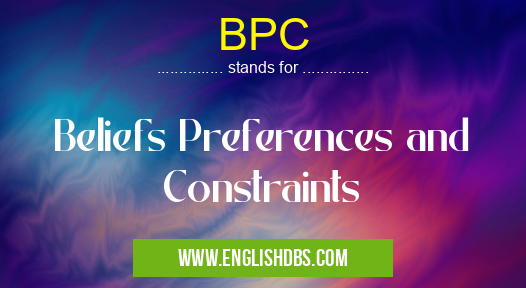What does BPC mean in UNCLASSIFIED
BPC stands for Beliefs, Preferences, and Constraints within MISCELLANEOUS. It is a crucial concept within behavioral economics, a field that seeks to understand how human psychology and cognitive biases influence decision-making and economic behavior.

BPC meaning in Unclassified in Miscellaneous
BPC mostly used in an acronym Unclassified in Category Miscellaneous that means Beliefs Preferences and Constraints
Shorthand: BPC,
Full Form: Beliefs Preferences and Constraints
For more information of "Beliefs Preferences and Constraints", see the section below.
What does BPC Mean?
BPC encompasses the following key elements:
- Beliefs: An individual's subjective convictions and perceptions about the world around them.
- Preferences: The relative importance or value that an individual assigns to different outcomes or actions.
- Constraints: External or internal factors that limit or shape an individual's choices and behaviors.
BPC in Behavioral Economics
BPC plays a significant role in behavioral economics by:
- Highlighting the non-rational aspects of decision-making: Beliefs, preferences, and constraints can deviate from purely rational models, leading to biases and deviations from optimal choices.
- Accounting for bounded rationality: Individuals have limited cognitive resources and information processing capacity, which can influence their BPC and subsequent decisions.
- Predicting real-world behavior: BPC helps explain why individuals often make choices that seem irrational or inconsistent with economic theory.
Practical Applications
Understanding BPC has practical applications in fields such as:
- Marketing: Tailoring marketing strategies to align with consumers' beliefs, preferences, and constraints.
- Public policy: Designing policies that consider the behavioral aspects of human decision-making.
- Behavioral finance: Predicting and mitigating biases in investment and financial decision-making.
Conclusion
BPC is an essential concept in behavioral economics that recognizes the influence of beliefs, preferences, and constraints on human decision-making. By understanding these factors, researchers, policymakers, and businesses can better predict and influence behavior for improved outcomes in various contexts.
Essential Questions and Answers on Beliefs Preferences and Constraints in "MISCELLANEOUS»UNFILED"
What is BPC?
BPC stands for Beliefs, Preferences, and Constraints. It is a framework used in decision-making to identify the underlying factors that influence our choices.
Why is BPC important in decision-making?
By understanding our beliefs, preferences, and constraints, we can make more informed and rational decisions. It helps us to identify the values and priorities that guide our choices, as well as the limitations that may affect our ability to achieve our goals.
How can I use BPC in my own decision-making?
To use BPC in your decision-making, start by identifying your beliefs about the situation. What are your assumptions and perspectives on the issue? Next, determine your preferences. What are your priorities and goals? Finally, identify any constraints that may limit your options. By considering all three elements of BPC, you can make decisions that are aligned with your values and objectives.
What is the difference between beliefs and preferences?
Beliefs are the assumptions and perspectives we hold to be true, while preferences are the outcomes or states of affairs that we desire. For example, you may believe that investing in the stock market is a good idea, and you may have a preference for a high return on your investment.
How do constraints affect decision-making?
Constraints are limitations or restrictions that limit our options. They can include factors such as time, resources, and social norms. By identifying the constraints that apply to a situation, we can better understand the feasibility of different choices and make decisions that are practical and realistic.
BPC also stands for: |
|
| All stands for BPC |
